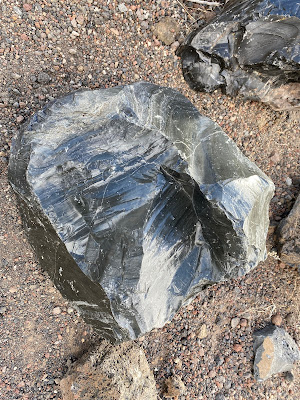Not all volcanoes are tall, pointy, conical mountains. Shield volcanoes are generally flat, with
gentle sloping sides. There are lots of
shield volcanoes in the world, Mauna
Loa and Kilauea in Hawaii are two well-known and very active ones. Medicine Lake volcano in Northeast California
is the largest volcano, by area, in the Cascade Range, but you may not have
heard of it before.
 |
| Acres and acres of lava |
The Medicine Lake volcano has been
active for 500,000 years. While
composite (pointy mountain) volcanoes have explosive eruptions, shield
volcanoes leak lava through surface vents.
Some of the resulting lava flows and empty lava tubes are preserved in
Lava Beds National Monument.
Lava Beds National Monument is in the middle of nowhere. The nearest town, Tulelake, is a tiny
crossroads that sits on the shores of
Tule Lake. Parts of Tule Lake itself have
been drained and reclaimed as agricultural land.
Because of the ways the roads run around there, most people enter
the park through the Northwest or Northeast entrances. The Visitor Center is in the Southern part of
the park. We were surprised as we drove
past acres and acres of hardened lava.
Signs at overlooks explain what you are seeing. Most of the lava erupted 30,000 – 40,000
years ago. There is a flow in the
Monument from as recent as 1,200 years ago.
Because of recent eruptions, and the potential of more, Medicine Lake is
considered a dormant volcano.
 |
| Lava builds up inside the tube with each new batch of lava |
Molten lava flows to the surface through lava tubes. As lava erupts through a vent, the lava along
the outside edges of the flow hardens first, creating a tube. Subsequent flows add layers to the inside of
the tube, much like the layers of an onion.
Sometimes, a chunk of a layer will pull off with the force of the flow
leaving an uneven indentation on the surface of the tube. After the last of the lava has left the tube,
liquid lava might harden as it drips from the ceiling creating lavacicles. (Does that sound to you like geologists might
have a sense of humor?)
 |
| Lavacicles |
Many of the lava tubes are now open as caves to explore. You get instructions on how to decontaminate
any gear or apparel that have previously been in a cave to stop the spread of
White Nose Syndrome in bats.
 |
| Descending into Mushpost Cave |
 |
| This is what the inside of a lava tube looks like |
We went in the Mushpot Cave.
It has lighting inside it, and signs explaining the features that you
are seeing. The other caves are not as
civilized, but you can borrow flashlights from the Visitor Center.
 |
| Schonchin Butte is a cinder cone |
The flat desert is dotted with rounded hills known as cinder
cones. Highly pressurized molten lava
explodes upward, cools mid-air, then falls back to the earth as rocks, which
eventually cover the vent. Then fluid
lava leaks along the base of the pile, moving the rocks and forming a rounded
cone. Folks in the area call them
buttes. The Schonchin Butte is quite
prominent in the park.
 |
| Captain Jack's Stronghold |
This area was the land of the Modoc native people for 10,000
years. As white settlers claimed
ancestral Modoc land, conflicts arose.
The Modoc reluctantly signed a treaty and were relocated to the Klamath
Reservation to the North in Oregon.
Conditions there were terrible, so a group of Modoc under the leadership
of Kientpoos (known as Captain Jack by the white settlers) returned to their
ancestral lands, wanting a reservation there.
 |
| Captain Jack's Stronghold |
They fled to a lava stronghold where warriors, women and children set up
a makeshift community and held off US Army forces. Eventually, the army cut off their access to
water in the lake and, half-starved, the Modoc were forced to surrender. Kientpoos was executed. The war was so costly to the US Army, that they almost eradicated all of the Modoc people afterwards.
.HEIC) |
| A nice welcome |
 |
| Our morning neighbors |
We camped that night in the campground inside the Monument.
There was a brief, gentle misty rain, and we
were greeted by a rainbow.
The next morning we saw a herd of mule deer grazing at the empty
campsite across the street from ours.
There are three kinds of lava
 |
| A'a |
 |
| Pahoehoe |
 |
| Obsidian |








.HEIC)







No comments:
Post a Comment